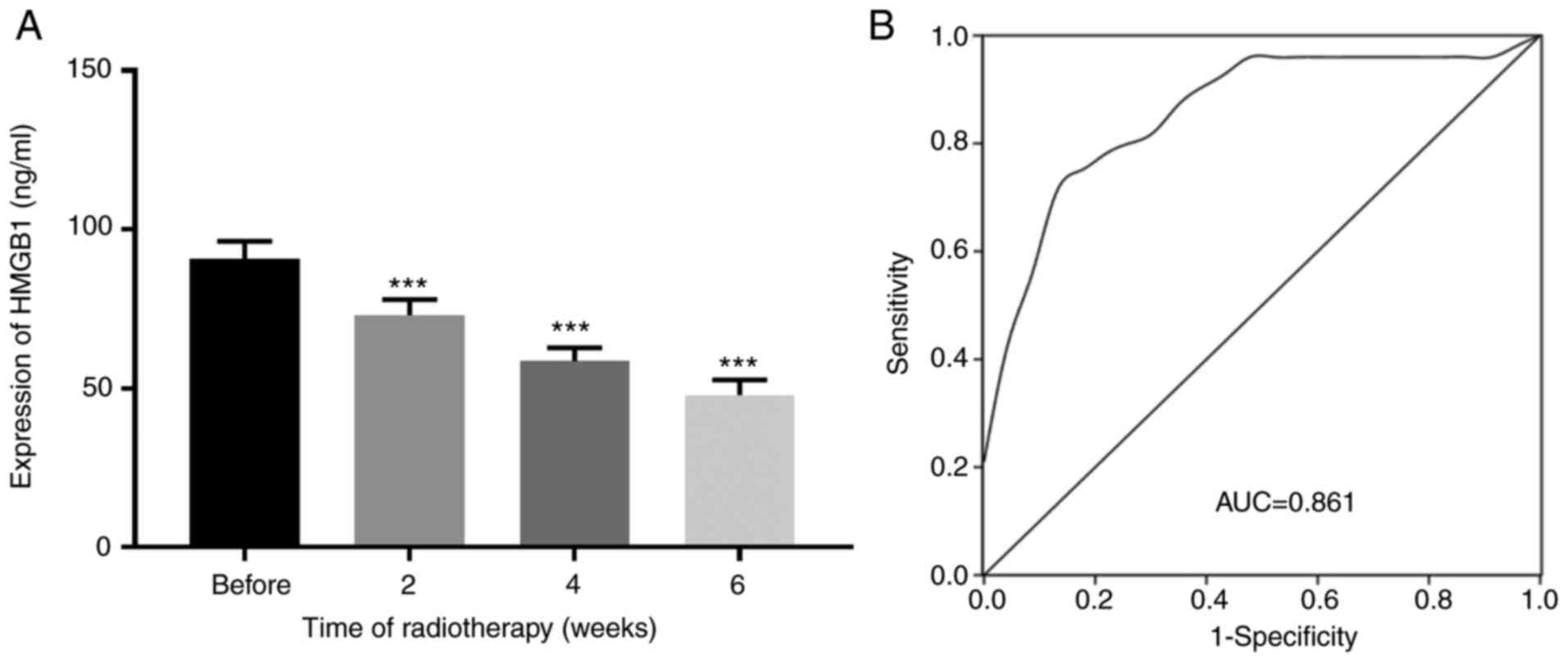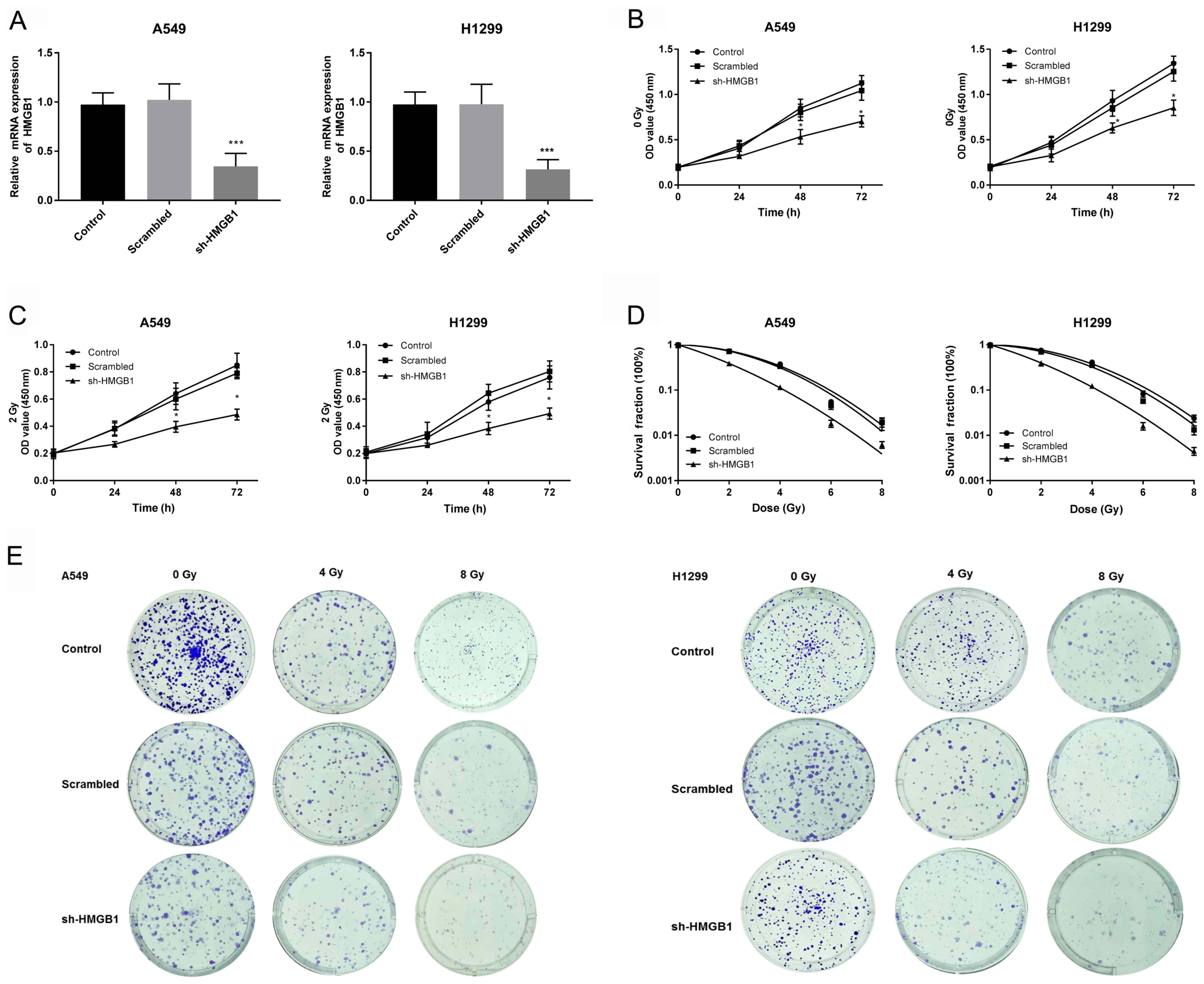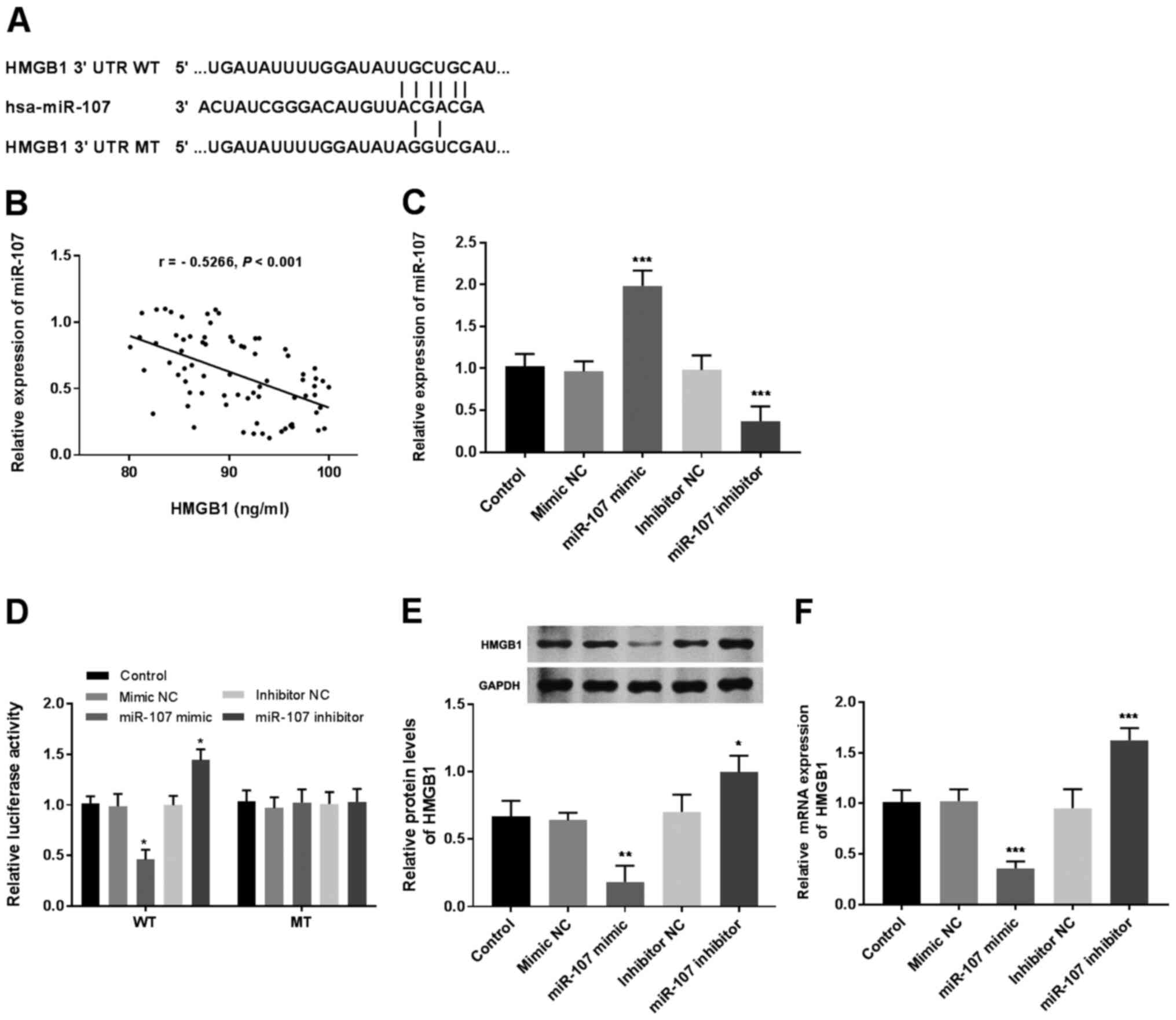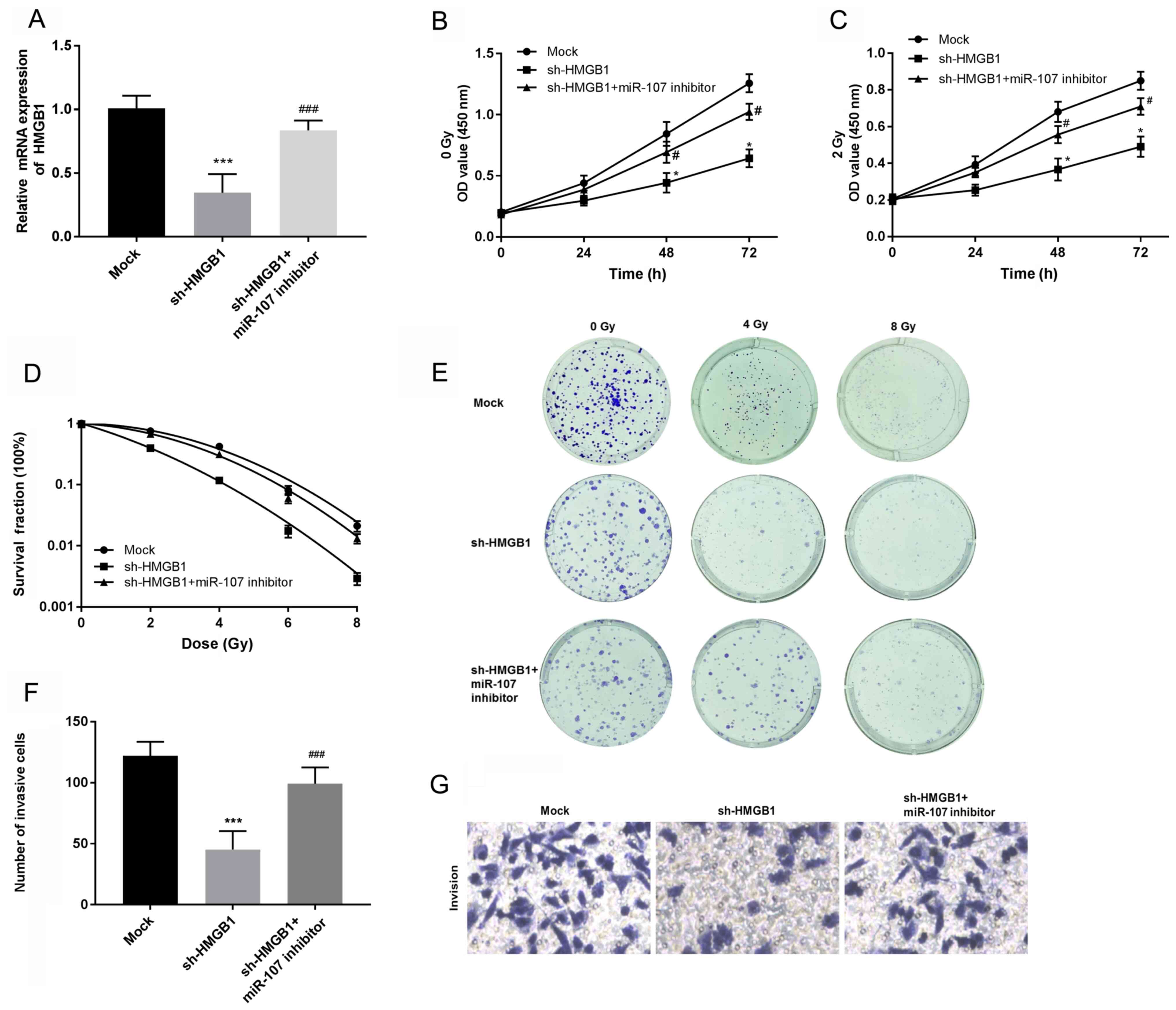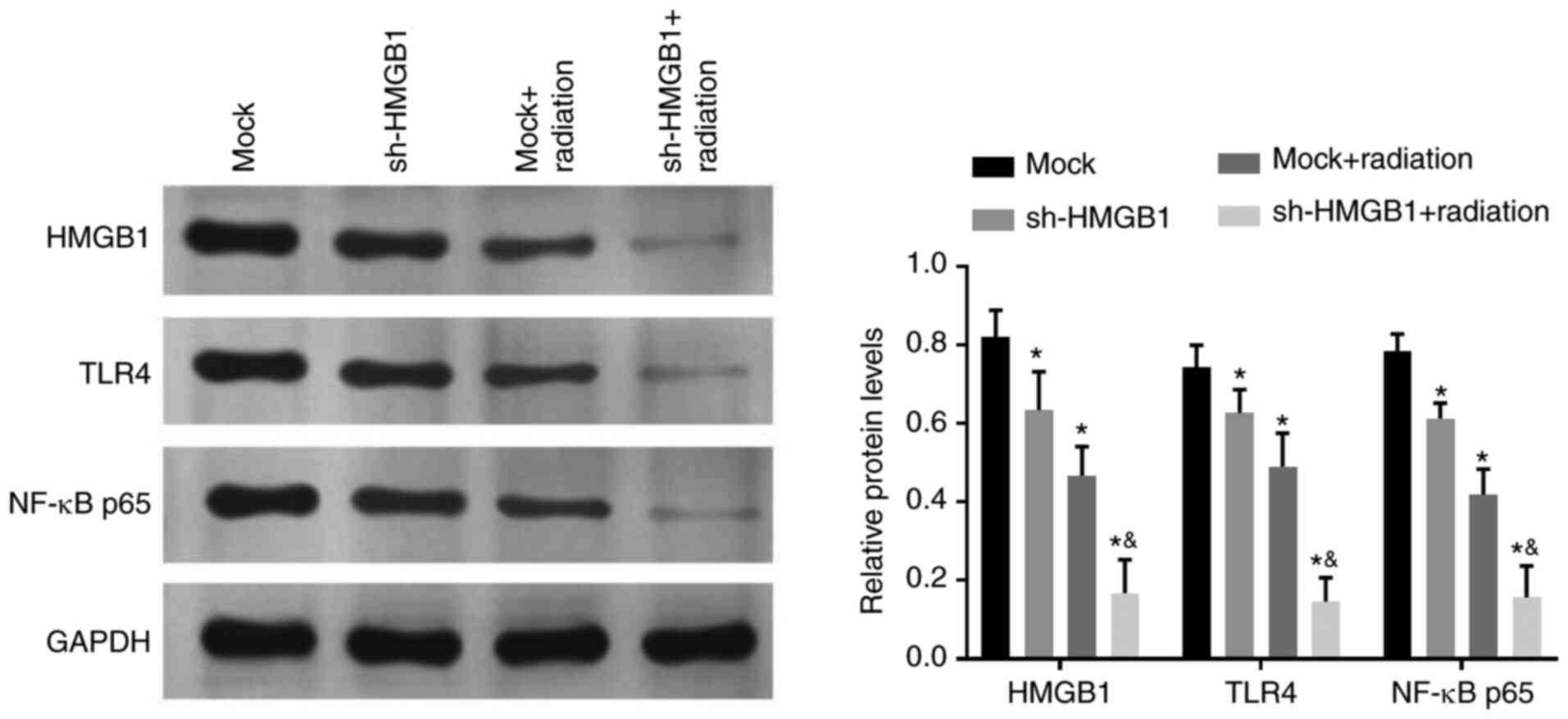|
1
|
Siegel RL, Miller KD and Jemal A: Cancer
statistics, 2019. CA Cancer J Clin. 69:7–34. 2019.PubMed/NCBI View Article : Google Scholar
|
|
2
|
Larsen JE and Minna JD: Molecular biology
of lung cancer: Clinical implications. Clin Chest Med. 32:703–740.
2011.PubMed/NCBI View Article : Google Scholar
|
|
3
|
Zhao L, Wang J, Li H, Che J, Ma N and Cao
B: Safety and Efficacy of Tianfoshen Oral Liquid in Non-Small Cell
Lung Cancer Patients as an Adjuvant Therapy. Evid Based Complement
Alternat Med. 2019(1375439)2019.PubMed/NCBI View Article : Google Scholar
|
|
4
|
Cheng P, Ma Y, Gao Z and Duan L: High
Mobility Group Box 1 (HMGB1) Predicts Invasion and Poor Prognosis
of Glioblastoma Multiforme via Activating AKT Signaling in an
Autocrine Pathway. Med Sci Monit. 24:8916–8924. 2018.PubMed/NCBI View Article : Google Scholar
|
|
5
|
Hou C, Chen Y, Huang X, Huang Q, Li M and
Tan X: miR-19 targets PTEN and mediates high mobility group protein
B1(HMGB1)-induced proliferation and migration of human airway
smooth muscle cells. PLoS One. 14(e0219081)2019.PubMed/NCBI View Article : Google Scholar
|
|
6
|
Yue Y, Zhou T, Gao Y, Zhang Z, Li L, Liu
L, Shi W, Su L and Cheng B: High mobility group box 1/toll-like
receptor 4/myeloid differentiation factor 88 signaling promotes
progression of gastric cancer. Tumour Biol.
39(1010428317694312)2017.PubMed/NCBI View Article : Google Scholar
|
|
7
|
Chen R, Zhu S, Fan XG, Wang H, Lotze MT,
Zeh HJ III, Billiar TR, Kang R and Tang D: High mobility group
protein B1 controls liver cancer initiation through yes-associated
protein-dependent aerobic glycolysis. Hepatology. 67:1823–1841.
2018.PubMed/NCBI View Article : Google Scholar
|
|
8
|
Huang CY, Chiang SF, Chen WT, Ke TW, Chen
TW, You YS, Lin CY, Chao KSC and Huang CY: HMGB1 promotes
ERK-mediated mitochondrial Drp1 phosphorylation for chemoresistance
through RAGE in colorectal cancer. Cell Death Dis.
9(1004)2018.PubMed/NCBI View Article : Google Scholar
|
|
9
|
Shi Y and Gong W: Upregulation of
miR-129-5p increases the sensitivity to Taxol through inhibiting
HMGB1-mediated cell autophagy in breast cancer MCF-7 cells. Braz J
Med Biol Res. 52(e8657)2019.PubMed/NCBI View Article : Google Scholar
|
|
10
|
Shrivastava S, Mansure JJ, Almajed W, Cury
F, Ferbeyre G, Popovic M, Seuntjens J and Kassouf W: The Role of
HMGB1 in Radioresistance of Bladder Cancer. Mol Cancer Ther.
15:471–479. 2016.PubMed/NCBI View Article : Google Scholar
|
|
11
|
Ma Y, Kang S, Wu X, Han B, Jin Z and Guo
Z: Up-regulated HMGB1 in the pleural effusion of non-small cell
lung cancer (NSCLC) patients reduces the chemosensitivity of NSCLC
cells. Tumori. 104:338–343. 2018.PubMed/NCBI View Article : Google Scholar
|
|
12
|
Zheng H, Chen JN, Yu X, Jiang P, Yuan L,
Shen HS, Zhao LH, Chen PF and Yang M: HMGB1 Enhances Drug
Resistance and Promotes In Vivo Tumor Growth of Lung Cancer Cells.
DNA Cell Biol. 35:622–627. 2016.PubMed/NCBI View Article : Google Scholar
|
|
13
|
Wu X, Wang W, Chen Y, Liu X, Wang J, Qin
X, Yuan D, Yu T, Chen G, Mi Y, et al: High Mobility Group Box
Protein 1 Serves as a Potential Prognostic Marker of Lung Cancer
and Promotes Its Invasion and Metastasis by Matrix
Metalloproteinase-2 in a Nuclear Factor-κB-Dependent Manner. Biomed
Res Int. 2018(3453706)2018.PubMed/NCBI View Article : Google Scholar
|
|
14
|
Bai H and Wu S: miR-451: A Novel Biomarker
and Potential Therapeutic Target for Cancer. Onco Targets Ther.
12:11069–11082. 2019.PubMed/NCBI View Article : Google Scholar
|
|
15
|
Chandan K, Gupta M and Sarwat M: Role of
Host and Pathogen-Derived MicroRNAs in Immune Regulation During
Infectious and Inflammatory Diseases. Front Immunol.
10(3081)2020.PubMed/NCBI View Article : Google Scholar
|
|
16
|
Chen G, Yu L, Dong H, Liu Z and Sun Y:
MiR-182 enhances radioresistance in non-small cell lung cancer
cells by regulating FOXO3. Clin Exp Pharmacol Physiol.
46(2):137–143. 2019.PubMed/NCBI View Article : Google Scholar
|
|
17
|
Li YH, Xu CL, He CJ, Pu HH, Liu JL and
Wang Y: circMTDH.4/miR-630/AEG-1 axis participates in the
regulation of proliferation, migration, invasion, chemoresistance,
and radioresistance of NSCLC. Mol Carcinog. 59:141–153.
2020.PubMed/NCBI View
Article : Google Scholar
|
|
18
|
Sun C, Zeng X, Guo H, Wang T, Wei L, Zhang
Y, Zhao J, Ma X and Zhang N: MicroRNA-125a-5p modulates
radioresistance in LTEP-a2 non-small cell lung cancer cells by
targeting SIRT7. Cancer Biomark. 27:39–49. 2020.PubMed/NCBI View Article : Google Scholar
|
|
19
|
Xia H, Li Y and Lv X: MicroRNA-107
inhibits tumor growth and metastasis by targeting the BDNF-mediated
PI3K/AKT pathway in human non-small lung cancer. Int J Oncol.
49:1325–1333. 2016.PubMed/NCBI View Article : Google Scholar
|
|
20
|
Zhang Z, Zhang L, Yin ZY, Fan XL, Hu B,
Wang LQ and Zhang D: miR-107 regulates cisplatin chemosensitivity
of A549 non small cell lung cancer cell line by targeting cyclin
dependent kinase 8. Int J Clin Exp Pathol. 7:7236–7241.
2014.PubMed/NCBI
|
|
21
|
Livak KJ and Schmittgen TD: Analysis of
relative gene expression data using real-time quantitative PCR and
the 2(-Delta Delta C(T)) Method. Methods. 25:402–408.
2001.PubMed/NCBI View Article : Google Scholar
|
|
22
|
Amornsupak K, Jamjuntra P, Warnnissorn M,
O-Charoenrat P, Sa-Nguanraksa D, Thuwajit P, Eccles SA and Thuwajit
C: High ASMA+ Fibroblasts and Low Cytoplasmic
HMGB1+ Breast Cancer Cells Predict Poor Prognosis. Clin
Breast Cancer. 17:441–452.e2. 2017.PubMed/NCBI View Article : Google Scholar
|
|
23
|
Suren D, Arda Gokay A and Sayiner A: High
Mobility Group Box 1 (HMGB1) expression in gastric adenocarcinomas.
J BUON. 23:422–427. 2018.PubMed/NCBI
|
|
24
|
Ohmori H, Luo Y, Fujii K, Sasahira T,
Shimomoto T, Denda A and Kuniyasu H: Dietary linoleic acid and
glucose enhances azoxymethane-induced colon cancer and metastases
via the expression of high-mobility group box 1. Pathobiology.
77:210–217. 2010.PubMed/NCBI View Article : Google Scholar
|
|
25
|
Zhang X, Yang X, Zhu S, Li Q and Zou N:
Radiosensitization of esophageal carcinoma cells by knockdown of
HMGB1 expression. Oncol Rep. 41:1960–1970. 2019.PubMed/NCBI View Article : Google Scholar
|
|
26
|
Liu Q, Huo Y, Zheng H, Zhao J, Jia L and
Wang P: Ethyl pyruvate suppresses the growth, invasion and
migration and induces the apoptosis of non small cell lung cancer
cells via the HMGB1/RAGE axis and the NF κB/STAT3 pathway. Oncol
Rep. 42:817–825. 2019.PubMed/NCBI View Article : Google Scholar
|
|
27
|
Wang K, Shan S, Wang S, Gu X, Zhou X and
Ren T: HMGB1-containing nucleosome mediates chemotherapy-induced
metastasis of human lung cancer. Biochem Biophys Res Commun.
500:758–764. 2018.PubMed/NCBI View Article : Google Scholar
|
|
28
|
Wu L and Yang L: The function and
mechanism of HMGB1 in lung cancer and its potential therapeutic
implications. Oncol Lett. 15:6799–6805. 2018.PubMed/NCBI View Article : Google Scholar
|
|
29
|
Liu K, Huang J, Ni J, Song D, Ding M, Wang
J, Huang X and Li W: MALAT1 promotes osteosarcoma development by
regulation of HMGB1 via miR-142-3p and miR-129-5p. Cell Cycle.
16:578–587. 2017.PubMed/NCBI View Article : Google Scholar
|
|
30
|
Di X, He G, Chen H, Zhu C, Qin Q, Yan J,
Zhang X and Sun X: High-mobility group box 1 protein modulated
proliferation and radioresistance in esophageal squamous cell
carcinoma. J Gastroenterol Hepatol. 34:728–735. 2019.PubMed/NCBI View Article : Google Scholar
|
|
31
|
Liu R, Chen Y, Shou T, Hu J and Qing C:
miRNA-99b-5p targets FZD8 to inhibit non-small cell lung cancer
proliferation, migration and invasion. Onco Targets Ther.
12:2615–2621. 2019.PubMed/NCBI View Article : Google Scholar
|
|
32
|
Wang L, Lv X, Fu X, Su L, Yang T and Xu P:
miR-153 inhibits the resistance of lung cancer to gefitinib via
modulating expression of ABCE1. Cancer Biomark. 25:361–369.
2019.PubMed/NCBI View Article : Google Scholar
|
|
33
|
Wu X, Ding N, Hu W, He J, Xu S, Pei H, Hua
J, Zhou G and Wang J: Down-regulation of BTG1 by miR-454-3p
enhances cellular radiosensitivity in renal carcinoma cells. Radiat
Oncol. 9(179)2014.PubMed/NCBI View Article : Google Scholar
|
|
34
|
Lin SS, Yuan LJ, Niu CC, Tu YK, Yang CY
and Ueng SWN: Hyperbaric oxygen inhibits the HMGB1/RAGE signaling
pathway by upregulating mir-107 expression in human osteoarthritic
chondrocytes. Osteoarthritis Cartilage. 27:1372–1381.
2019.PubMed/NCBI View Article : Google Scholar
|
|
35
|
Ai H, Zhou W, Wang Z, Qiong G, Chen Z and
Deng S: MicroRNAs-107 inhibited autophagy, proliferation, and
migration of breast cancer cells by targeting HMGB1. J Cell
Biochem. Dec 2, 2018 (Epub ahead of print). doi:
10.1002/jcb.28157.
|
|
36
|
Chen G, Ward MF, Sama AE and Wang H:
Extracellular HMGB1 as a proinflammatory cytokine. J Interferon
Cytokine Res. 24:329–333. 2004.PubMed/NCBI View Article : Google Scholar
|
|
37
|
Li Z, Block MS, Vierkant RA, Fogarty ZC,
Winham SJ, Visscher DW, Kalli KR, Wang C and Goode EL: The
inflammatory microenvironment in epithelial ovarian cancer: A role
for TLR4 and MyD88 and related proteins. Tumour Biol.
37:13279–13286. 2016.PubMed/NCBI View Article : Google Scholar
|
|
38
|
Bai M, Ma X, Li X, Wang X, Mei Q, Li X, Wu
Z and Han W: The Accomplices of NF-κB Lead to Radioresistance. Curr
Protein Pept Sci. 16:279–294. 2015.PubMed/NCBI View Article : Google Scholar
|
|
39
|
Jung CH, Han AR, Chung HJ, Ha IH and Um
HD: Linarin inhibits radiation-induced cancer invasion by
downregulating MMP-9 expression via the suppression of NF-κB
activation in human non-small-cell lung cancer A549. Nat Prod Res.
33:3582–3586. 2019.PubMed/NCBI View Article : Google Scholar
|
|
40
|
Liu YC, Chiang IT, Hsu FT and Hwang JJ:
Using NF-κB as a molecular target for theranostics in radiation
oncology research. Expert Rev Mol Diagn. 12:139–146.
2012.PubMed/NCBI View Article : Google Scholar
|
|
41
|
Jiang C, Qu X, Ke H, Gong W, Chen R, Yang
W and Cheng Z: Association between the HMGB1/TLR4 signaling pathway
and the clinicopathological features of ovarian cancer. Mol Med
Rep. 18:3093–3098. 2018.PubMed/NCBI View Article : Google Scholar
|
|
42
|
Tang H, Wang F, Zhou XF, Zhou J, Chen L,
Luo JD and Xu EC: Relationship between TLR4 and NF-κB p65 protein
expressions and clinical radiosensitivity of patients with
esophageal squamous cell carcinoma. Pak J Med Sci. 30:982–985.
2014.PubMed/NCBI View Article : Google Scholar
|
|
43
|
Zhi-Feng W, Le-Yuan Z, Xiao-Hui Z, Ya-Bo
G, Jian-Ying Z, Yong H and Zhao-Chong Z: TLR4-dependent immune
response promotes radiation-induced liver disease by changing the
liver tissue interstitial microenvironment during liver cancer
radiotherapy. Radiat Res. 182:674–682. 2014.PubMed/NCBI View Article : Google Scholar
|















